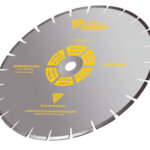So, you’ve taken on a project that requires cutting stone. If you’re reading this post, you have most likely realized by now that this will require a wet saw. However, you might have never heard about wet saws for cutting stone, or even be able to conceptualize how a wet saw might work. For absolute beginners who just need the basics on this type of machinery, we’ve created this simple and brief guide to wet saws for cutting stone, also known as “masonry saws”.
Contents
Why do you need a wet saw to cut stone?
If you’ve ever walked through the city while workers were doing street repairs with a jackhammer, then you have an idea of how much dust can get kicked up when cutting through stone, concrete and similar materials. That dust might seem like nothing more than an annoyance, but it can actually cause severe lung damage. Using a wet saw minimizes the dust that is produced when cutting stone.
Aside from that, stone is hard to cut! It creates a lot of friction between the blade and the material being cut, which can cause overheating. When things get too hot, things can get dangerous. In the best of circumstances, your blade won’t be happy (and you want to keep your blade happy – they aren’t cheap). Having a stream of water flowing over the blade and stone cools things down so that everybody’s happy.
How does a wet saw even work?
The phrase “wet saw” might conjure up nightmare scenarios of mixing electricity with water, but, while you should always use caution, these machines are designed to keep a safe distance between these two unfriendly elements.
Most masonry saws have an attached water tank and pump that will direct a stream of water over the blade and the stone in front of the blade, for the reasons discussed in the section above. In some cases, there won’t be a tank or pump, but a hose attachment where you’ll have to hook the wet saw up to a garden hose.
The way the machine is built, none of this water will enter the saw’s engine or other moving parts (provided it’s in good condition). The place where you need to be most careful is the electrical outlet if your masonry saw is electric vs. petrol.
How do you cut stone with a wet saw?
The other essential piece of the puzzle needed to cut stone with a wet saw is the proper blade. All stone is cut with a diamond blade, but not all diamond blades are the same. You should try to find a blade that is specifically indicated for the type of stone you have (e.g. granite, marble, slate, etc.).
Most wet saws for cutting stone have a solid table that you will place the stone on, lining up the blade with wherever you want to cut. After you’ve checked that the machine is in good shape and the diamond blade is properly mounted, and that water is flowing, you will power the saw on to start the blade. Then, holding the stone steady (if it isn’t heavy enough to hold itself), grasp the handle of the cutting head and slowly slide it towards the stone.
Just keep pressing gently on the cutting head as the blade works its way through the stone. Once you reach the end, power the machine off, and repeat on your next piece if necessary.





